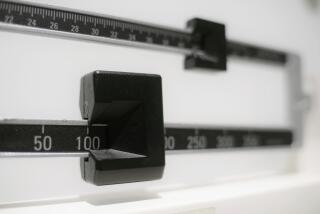Heavy Eaters in Company Cafeteria : Cut Calories With Good Food Choices, Dietitians Say
- Share via
The company cafeteria, a haven of relaxation for some, can also be a bugaboo for overweight individuals who make inappropriate food choices.
“If abused, the cafeteria is an easy access road to obesity and injurious eating patterns for people who habitually make poor food choices,” said Rita Storey, registered dietitian, representing the California Dietetic Assn.
Age and sex seemed to be determinant in food abuse in the company cafeteria, according to Storey and fellow consulting dietitian Sharon Higgins.
“After observing 163 employees’ trays in one downtown cafeteria, we found that more women than men were overweight. The overweight men seemed to be close to retirement age, but the overweight women were not.”
Overweight Employees Eat Extras
According to Storey’s notations, the overweight employees often chose gravy, meat, mashed and sweet potatoes, extra butter and cookies. There was heavy use of sweeteners, such as sugar or honey. The overweight also chose cream soups over clear soups. The overweight individuals also drank coffee with cream, more often chose a soda and had double servings of bread and starch.
Storey and Higgins observed that the normal-weight men chose a greater variety of foods than overweight women. Variety in the diet ensures intake of essential but hard-to-get minerals normally missing in an unvaried diet.
Slender older women who were observed ate less, choosing such foods as salads, soups, milk or coffee. Younger adults did not choose a variety of foods. But young women chose more fruit and vegetables than the men.
Well, how does one make proper food choices on one’s own? “There are certain things one can do to start,” Storey said.
Here are some of the dietitians’ suggestions:
--Look for nutrient-dense foods that contribute more to the nutrient column than the fat and sugar column.
--Look for foods that are high in nutrients and relatively low in calories, such as fruits and vegetables in their whole, raw state; low-fat dairy products; lean meats; fish and chicken without skin, and hard-cooked eggs.
Here are some more tips for breakfast, lunch and snacks:
Breakfast: For breakfast, look for foods that don’t have extra fat or are fried. A good breakfast would contain a grain food with fruit or an egg with milk or juice. Some examples:
--Hot cereal with milk, with or without raisins.
--Omelet made with one egg rather than three eggs and filled with vegetables instead of higher-calorie cheese.
Lunch: A good lunch would contain soup, salad or sandwich with fruit and nonfat milk or juice. Some ideas:
--Soup made with vegetables or legumes eaten with whole-grain cracker or a roll.
--Small salad with fruit and nonfat milk or juice. But watch the salad dressing. Use one tablespoon dressing for a small salad and two for a large salad. Lemon juice, which contains no calories, can be substituted.
--Mixed vegetable juice, such as cocktail vegetable juice, or other mixed-vegetable fruit juice, with cracked wheat crackers or crisps.
--Sandwich that is not fried or laden with meat and cheese.
--Vegetable plate, which includes a variety or double order of a favorite vegetable. Sprinkle with a teaspoon of Parmesan cheese for added nutrients and flavor.
--Baked potato topped with steamed vegetables and a small amount of dressing added.
Snacks: “If people have eaten the foods we are talking about, they would not need many snacks. But snacks should be foods such as whole fruit, fruit juice and mixed vegetable juice. Diet sodas should be consumed only in moderation, especially by children, because we don’t know enough about the physiology of the metabolism involved,” Storey said.
Good snacks are crackers. They have less fat than chips and puffed cheese snacks.
Avoid chips and peanuts. Nuts have good nutrition but are very high in fat (about 105 calories for 10 peanuts.
Another idea is to share a snack with a co-worker. “That way you are getting only half or quarter of the calories, while enjoying a refreshment,” Storey said.
Storey has observed that individuals with a slim image of themselves tend to make better food choices than those with a fat self-image.
“Maybe it would be wise to use imagery to guide our daily food choices. With a little education about eating a variety of foods in a balanced and nutrient-dense, not calorie-dense way, then we can probably do well,” Storey said.
Exercise is also a key to weight control, and some form of exercise should be incorporated into any dietary program.
Storey recommends that people with weight problems consult a dietitian who specializes in weight management and control. You can find a dietitian in your area by calling Consulting Nutritionists, (213) 459-9343.
More to Read
Eat your way across L.A.
Get our weekly Tasting Notes newsletter for reviews, news and more.
You may occasionally receive promotional content from the Los Angeles Times.










